The Valencene Market is estimated to be valued at USD 6.1 million in 2025 and is projected to reach USD 10.1 million by 2035, registering a compound annual growth rate (CAGR) of 5.2% over the forecast period.
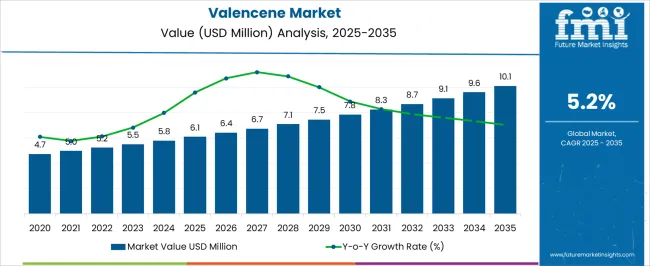
| Metric | Value |
|---|---|
| Valencene Market Estimated Value in (2025 E) | USD 6.1 million |
| Valencene Market Forecast Value in (2035 F) | USD 10.1 million |
| Forecast CAGR (2025 to 2035) | 5.2% |
The valencene market is experiencing a steady rise in demand, driven by growing interest in natural ingredients across the food, beverage, and cosmetic industries. Sourced primarily from citrus fruits, valencene is being increasingly adopted for its aromatic profile, flavor enhancement, and functional benefits.
As consumers continue to prioritize clean label products and plant based additives, manufacturers are scaling production through sustainable extraction processes and biotechnology. Regulatory support for natural flavoring agents, especially in North America and Europe, is further encouraging adoption.
Additionally, expanding applications in fragrance formulation and skincare are opening new growth avenues. The market outlook remains strong, supported by innovations in purity enhancement and value chain optimization across both developed and emerging markets.
The market is segmented by Purity Grade, Application, and Distribution Channel and region. By Purity Grade, the market is divided into <60%, 60%-65%, 66%-70%, 71%-75%, 76%-80%, and >80%. In terms of Application, the market is classified into Food & Beverage, Personal Care, and Home Care. Based on Distribution Channel, the market is segmented into Offline and Online. Regionally, the market is classified into North America, Latin America, Western Europe, Eastern Europe, Balkan & Baltic Countries, Russia & Belarus, Central Asia, East Asia, South Asia & Pacific, and the Middle East & Africa.
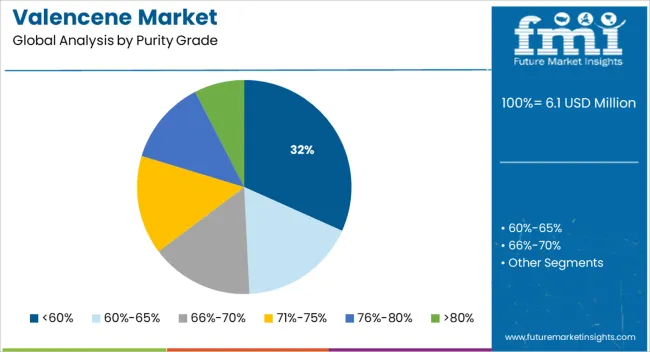
The less than 60% purity grade segment is projected to account for 31.70% of the total market revenue by 2025. This dominance is linked to its cost effectiveness and sufficient performance in flavor and fragrance applications that do not require highly refined forms.
Manufacturers across food and beverage sectors continue to opt for this grade due to its balance between price and functionality. The lower production cost also supports its widespread adoption in emerging markets where cost sensitivity remains a key consideration.
Additionally, this grade is being increasingly utilized in formulations where valencene acts as a base note or intermediate ingredient, reinforcing its demand across mid-tier product lines.
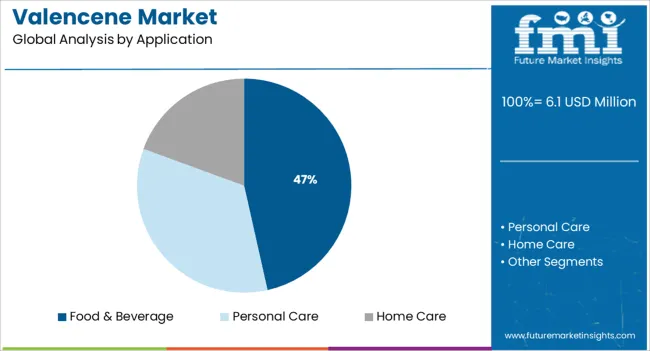
The food and beverage segment is expected to contribute 46.50% of the total market revenue by 2025, emerging as the leading application. This segment’s growth is driven by increasing consumer demand for natural flavors and citrus based enhancers in products such as carbonated drinks, confectionery, and health beverages.
Valencene offers a natural alternative to synthetic flavoring agents and aligns with regulatory shifts promoting clean label compliance. Additionally, its compatibility with multiple formulation systems and high aroma retention make it ideal for a wide range of food and beverage products.
The industry’s move toward plant derived additives continues to solidify this segment’s dominance.
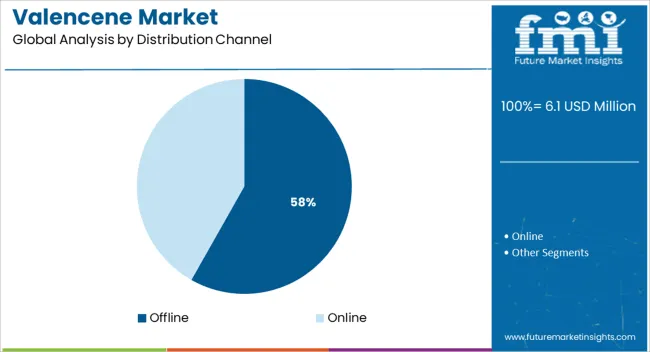
The offline segment is projected to hold 58.20% of total revenue by 2025, positioning it as the primary distribution channel. This is attributed to the established network of bulk distributors, ingredient wholesalers, and specialty chemical suppliers who maintain strong relationships with manufacturers.
Offline distribution also facilitates direct quality inspections, customized order fulfillment, and technical support, which are critical in the flavor and fragrance sector.
Despite the rise of digital platforms, the complexity of B2B transactions and regulatory considerations in ingredient sourcing continue to favor traditional offline channels, sustaining their market leadership.
The global market is expected to reach USD 10.1 Million by 2035. The market is anticipated to register a CAGR of 5.2% over the forecast period. Increasing demand for natural and organic ingredients in the personal care and cosmetics industry is expected to drive the market over the forecast period.
Valencene is an important fragrance ingredient used in a wide range of personal care and cosmetics products such as skin care, hair care, and fragrances. It is derived from Valencia oranges and has a fresh, citrusy aroma. The compound has antimicrobial and antioxidant properties that would make it an ideal ingredient for personal care formulations.
A number of influential factors have been identified to stir the soup in the market. Apart from the proliferating aspects prevailing in the market, analysts at FMI have also analyzed the restraining elements, lucrative opportunities, and upcoming threats that can pose a challenge to the progression of the market.
The drivers, restraints, opportunities, and threats (DROTs) identified are as follows:
DRIVERS
RESTRAINTS
OPPORTUNITIES
THREATS
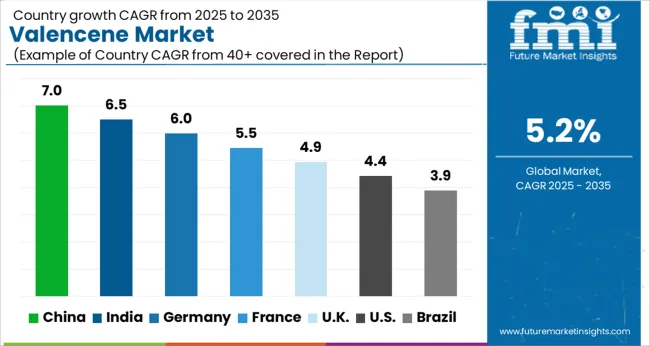
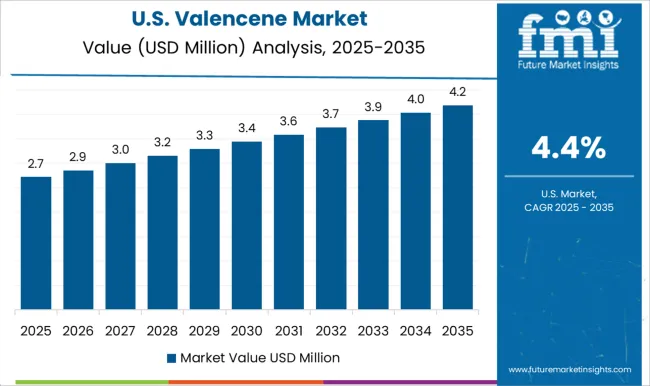
Increasing Demand for Orange Juice in the USA to Spur Sales of Valencene Terpene
Valencene is a type of citrus fruit that is grown in the Mediterranean region. It is used to make orange juice, lemonade, and other citrus drinks. In North American countries like the USA, valencene is used to make orange juice and other citrus drinks. It is also expected to be used extensively in perfumes and cosmetics.
Valencene is often affected by the climate in the USA It needs warm weather and a lot of sunlight to grow. If the weather is too cold or if there is not enough sunlight, valencene will not grow well across the USA This factor may affect the market negatively in the evaluation period.
High Sales of Cocktails, Wine, and Beer in India to Drive the Demand for Valencene Synthase
Valencene has a woody, citrusy aroma and is used as a flavoring agent in food and beverages. In India, valencene is used in several different ways. It is mainly used as a flavor enhancer in food and beverages.
Valencene is usually added to various foods and drinks to enhance its flavors. Some of the foods that valencene is often added to include soups, stews, sauces, and marinades. Valencene is also used as a flavoring agent in alcoholic beverages such as beer, wine, and cocktails. The country is expected to use the ingredient in medicines due to its anti-inflammatory and antibacterial properties.
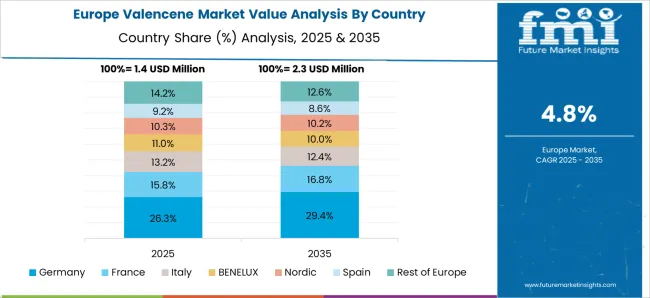
Investments by Germany in Spanish Orange Growers to Bolster Sales of Valencene Aroma
Germany dominated the Europe market in the historical period. In recent years, however, Spain has been the leading producer of valencene. This is due to the fact that Spain's climate is more conducive to the growth of Valencia oranges, which are used to produce valencene.
Germany has responded to this change in market dynamics by investing in Spanish orange growers. This has allowed them to control a large portion of the Europe market for valencene. In addition, Germany has been working on developing new methods of producing valencene, which would spur sales.
Launch of Unique Orange Flavored Food and Beverages to Propel Sales of Valencene Strains
Based on application, the food and beverage segment is anticipated to remain at the forefront in the next ten years. Increasing demand for orange-flavored food and beverages, especially among kids and young adults is estimated to bolster sales in the global market. In January 2025, for instance, Jameson launched Jameson Orange: An Irish Whiskey infused with citrus flavors to solidify its place in the flavored whiskey category. The launch of similar products by renowned food and beverage companies to attract a large client base is anticipated to push growth.
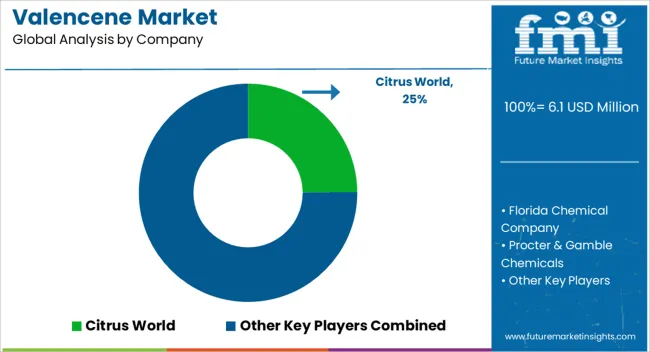
The global market is growing at a moderate rate and is expected to continue doing so during the forecast period. Key companies in the market are striving to keep up with the increasing demand for natural flavors from the food and beverage industry worldwide. They are thus focusing on in-depth research and development activities to come up with unique product lines.
The global market is highly fragmented with the presence of a large number of small and medium-sized manufacturers. Some of the key players in the market are Citrus World, Florida Chemical Company, Procter & Gamble Chemicals, Symrise AG, Isobionics, Evolva, Vishal essential oils and chemicals, Cvista, and Panta Manufacturing Company among others.
For instance,
| Attribute | Details |
|---|---|
| Estimated Market Size (2025) | USD 6.1 million |
| Projected Market Valuation (2035) | USD 10.1 million |
| Value-based CAGR (2025 to 2035) | 5.2% |
| Forecast Period | 2025 to 2035 |
| Historical Data Available for | 2020 to 2025 |
| Market Analysis | Value (USD Million) |
| Key Regions Covered | North America; Latin America; Europe; Asia Pacific; Oceania; Middle East and Africa(MEA) |
| Key Countries Covered | USA, Canada, Mexico, Germany, United Kingdom, France, Italy, Spain, China, Japan, India, South Korea, Australia, Brazil, Argentina, South Africa, United Arab Emirates(UAE) |
| Key Segments Covered | Purity Grade, Application, Distribution Channel, Region |
| Key Companies Profiled | Citrus World; Florida Chemical Company; Procter & Gamble Chemicals; Symrise AG.; Isobionics; Evolva; Vishal essential oils and chemicals; Cvista; Panta manufacturing company |
| Report Coverage | Market Forecast, Company Share Analysis, Competitive Landscape, Drivers, Restraints, Opportunities and Threats Analysis, Market Dynamics and Challenges, and Strategic Growth Initiatives |
The global valencene market is estimated to be valued at USD 6.1 million in 2025.
The market size for the valencene market is projected to reach USD 10.1 million by 2035.
The valencene market is expected to grow at a 5.2% CAGR between 2025 and 2035.
The key product types in valencene market are <60%, 60%-65%, 66%-70%, 71%-75%, 76%-80% and >80%.
In terms of application, food & beverage segment to command 46.5% share in the valencene market in 2025.






Full Research Suite comprises of:
Market outlook & trends analysis
Interviews & case studies
Strategic recommendations
Vendor profiles & capabilities analysis
5-year forecasts
8 regions and 60+ country-level data splits
Market segment data splits
12 months of continuous data updates
DELIVERED AS:
PDF EXCEL ONLINE

Thank you!
You will receive an email from our Business Development Manager. Please be sure to check your SPAM/JUNK folder too.
Chat With
MaRIA